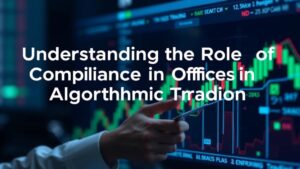Spotlighting the Power of Data
Data-driven insights are transforming the way we approach investing. Here’s how algorithms are reshaping the rules.
MiFID II and Its Impact on Algorithmic Trading in Europe
The financial landscape of Europe has been significantly transformed by the introduction of the Markets in Financial Instruments Directive II (MiFID II). Implemented on January 3, 2018, MiFID II is a comprehensive regulatory framework that aims to increase transparency, enhance investor protection, and foster competition within the financial markets. Among the many areas affected by this legislation, algorithmic trading stands out as one of the most profoundly impacted. In this article, we will explore the key features of MiFID II and its ramifications for algorithmic trading in Europe.
Before diving into the implications for algorithmic trading, it’s essential to grasp what MiFID II entails.
Key Objectives of MiFID II
- Transparency**: MiFID II seeks to improve the transparency of financial markets by mandating pre- and post-trade reporting.
- Investor Protection**: The directive strengthens protections for retail investors and requires firms to act in the best interest of their clients.
- Market Structure**: MiFID II introduces new trading venues and sets out rules to regulate high-frequency trading and algorithmic trading practices.
- Data Reporting**: Enhanced reporting requirements ensure that regulators have better visibility into market activities.
Major Components of MiFID II
- **Organized Trading Facilities (OTFs)**: MiFID II introduced OTFs as a new trading venue category alongside regulated markets and multilateral trading facilities (MTFs).
- **Best Execution**: Firms are required to take all reasonable steps to obtain the best possible result for their clients when executing orders.
- **Transaction Reporting**: The directive mandates detailed transaction reporting to ensure accountability and transparency in trading activities.
- **Product Governance**: Firms must ensure that financial products are designed to meet the needs of specific target markets.
Algorithmic Trading Defined
Algorithmic trading refers to the use of computer algorithms to automate trading strategies, allowing for the execution of orders at speeds and volumes that are impossible for human traders.
Characteristics of Algorithmic Trading
- Speed**: Algorithms can execute trades in milliseconds, capitalizing on market inefficiencies.
- Volume**: High-frequency trading (HFT) allows for the execution of thousands of orders simultaneously.
- Data-Driven**: Algorithms rely on vast datasets and complex mathematical models to make trading decisions.
MiFID II’s Impact on Algorithmic Trading
With a clear understanding of MiFID II, let’s examine how this directive has influenced algorithmic trading in Europe.
1. Enhanced Transparency and Reporting Requirements
One of the most significant impacts of MiFID II on algorithmic trading is the increase in transparency and reporting requirements.
Implications:
- Pre-Trade Transparency**: Trading venues now need to publish bid and offer prices and the depth of trading interest before transactions occur.
- Post-Trade Reporting**: Firms must report trades to regulators within a specified time frame (generally within 15 minutes), ensuring that all market participants have access to the same information.
2. Best Execution Obligations
MiFID II mandates that trading firms must ensure the best execution of client orders, a requirement that influences algorithmic trading strategies.
Implications:
- Execution Quality**: Algorithms must be programmed to consider various factors (price, costs, speed, likelihood of execution) to achieve the best result for clients.
- Monitoring Compliance**: Firms must continuously monitor and assess the execution quality of their algorithms, making adjustments as needed to meet regulatory standards.
3. Introduction of Limitations on High-Frequency Trading
MiFID II has introduced regulations specifically aimed at high-frequency trading, which often employs algorithmic strategies.
Implications:
- HFT Registration**: Firms engaging in high-frequency trading must register with regulators and demonstrate that they have adequate risk controls in place.
- Market Making Obligations**: Market makers using algorithmic trading strategies are required to maintain continuous quotes and ensure liquidity.
4. Improved Risk Management Practices
The regulatory framework has prompted firms to enhance their risk management practices related to algorithmic trading.
Implications:
- Robust Controls**: Firms are now required to implement more robust controls to monitor and manage algorithmic trading risks, including pre-trade risk checks to mitigate potential market disruptions.
- Testing and Validation**: Algorithms must undergo rigorous testing and validation processes to ensure they operate as intended and comply with regulatory standards.
5. Impact on Market Structure and Competition
MiFID II has also reshaped the competitive landscape for algorithmic trading in Europe.
Implications:
- New Trading Venues**: The introduction of OTFs has increased the number of venues where algorithmic trading can occur, fostering competition among trading platforms.
- Increased Costs**: Compliance with MiFID II can be costly for firms, leading to potential barriers to entry for smaller players in the algorithmic trading space.
Real-world Applications and Examples
To illustrate the impact of MiFID II on algorithmic trading, let’s consider a few real-world applications.
Case Study: A Major Investment Bank
A well-known investment bank operating in Europe has revamped its algorithmic trading platform to comply with MiFID II.
- Transparency Measures**: The bank implemented advanced analytics to enhance pre- and post-trade transparency, allowing clients to see real-time market data.
- Best Execution**: The algorithms were updated to incorporate multiple execution venues, ensuring optimal order execution in line with MiFID II requirements.
- Risk Management**: The bank established a dedicated team to monitor algorithm performance and ensure compliance with all risk management protocols.
Example: Retail Brokerage Firms
Many retail brokerage firms have had to adapt their algorithmic trading offerings to meet MiFID II standards.
- User-Friendly Interfaces**: These firms have developed more user-friendly platforms to accommodate retail investors, ensuring that they understand the best execution processes.
- Educational Initiatives**: To comply with investor protection mandates, firms have launched educational initiatives to help clients better understand algorithmic trading and its risks.
Conclusion
MiFID II has undoubtedly reshaped the landscape of algorithmic trading in Europe, introducing a host of regulations designed to enhance market transparency, protect investors, and promote fair competition. While the directive presents challenges for firms operating in this space, it also offers opportunities for improved practices and innovation.
As the financial markets continue to evolve, algorithmic trading will remain a crucial component of the trading ecosystem. Firms that embrace the regulatory changes and adapt their strategies accordingly will not only comply with MiFID II but also position themselves for success in an increasingly competitive environment. The future of algorithmic trading in Europe is bright, provided that firms prioritize transparency, best execution, and robust risk management.



